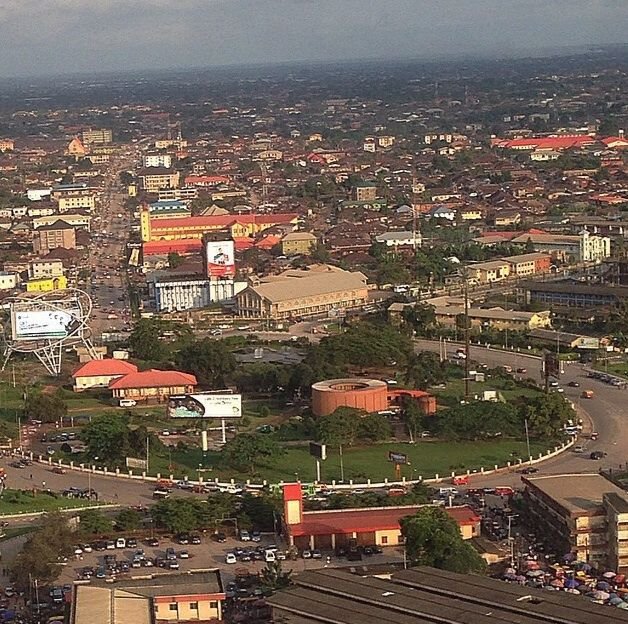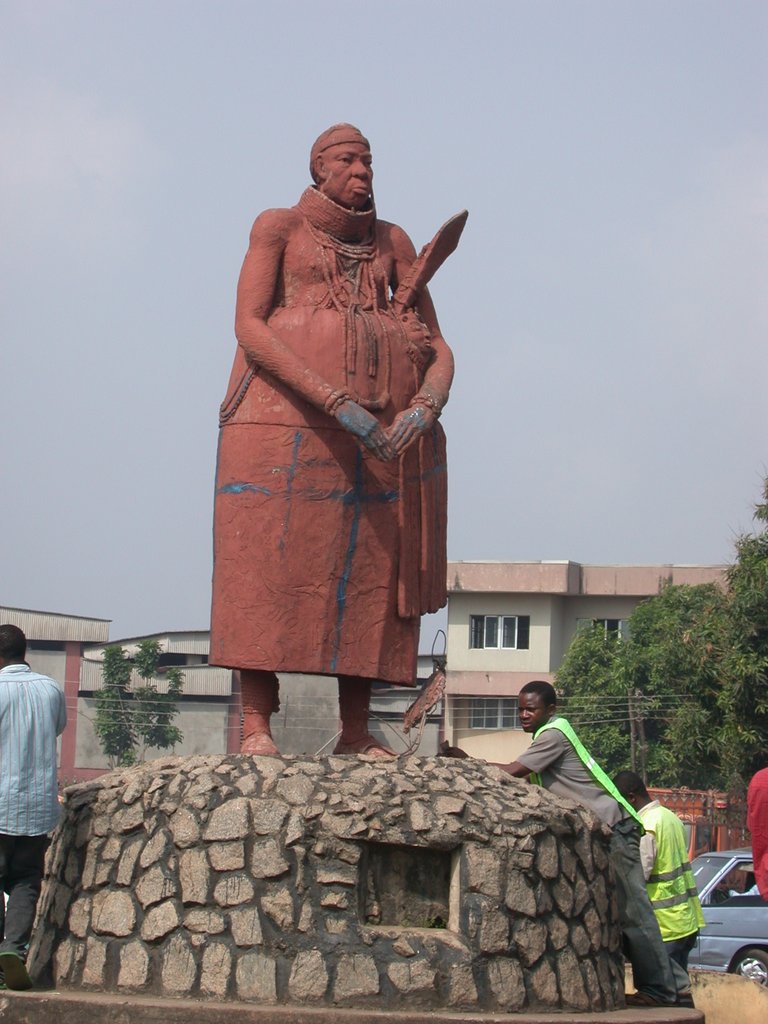
Benin City, is a city (2006 est. pop. 1,147,188) and the capital of Edo State in southern Nigeria. It is a city approximately 25 miles north of the Benin River. It is situated 200 miles by road east of Lagos. Benin is the centre of Nigeria's rubber industry, but processing palm nuts for oil is also an important traditional industry
The mythic origins of Benin state that the city was originally under the rule of Ogisos, meaning "Kings of the Sky". When the last Ogiso died, the nobles and chiefs disagreed over who would be the next Ogiso, so the Benin sent a message to Ife to the Ooni of Ile-Ife. Oba Oduduwa, the mythic ancient first king of Ife.
The Benin pleaded with him to send them a king; eventually Oduduwa sent to them his grandson, prince Oranmiyan. When Oranmiyan came to Benin, he struggled with the culture and customs of the Benin people. Because of his own difficulties acclimating to his new kingdom, Oba Oranmiyan changed the name of the city to Ile-Ibinu (1180-1897) which in the Yoruba language means the "Land of Vexation," and decided to leave the city. However, before leaving Benin, Oranmiyan had a son, Eweka, by princess Erewinde who could not talk. When Oranmiyan heard of this, he sent to him seven marbles for the child to play with.One day, as the prince was playing, one of the marbles broke. He immediately said "owomika!" or "eweka!", meaning "I succeeded!" He immediately became the first true Oba of Benin, Oba Eweka I.
Oba Eweka was the first to reject the title of the native Benin "Ogiso" and took the title "Oba," meaning 'king' in the Yoruba language. Allegedly Oba Eweka later changed the name of the city of Ile-Binu, the capital of the Benin kingdom, to "Ubinu." This name would be reinterpreted by the Portuguese as "Benin" in their own language. Around 1470, Ewuare changed the name of the state to Edo. This was about the time the people of Okpekpe migrated from Benin City.
The Portuguese visited Benin City around 1485. Benin grew rich during the 16th and 17th centuries due to trade within southern Nigeria, as well as through trade with Europeans, mostly in pepper and ivory.
In the early 16th century the Oba sent an ambassador to Lisbon, and the King of Portugal sent Christian missionaries to Benin. Some residents of Benin could still speak a pidgin Portuguese in the late 19th century. Many Portuguese loan words can still be found today in the languages of the area.
On 1 February 1852 the whole Bight of Benin became a British protectorate, where a consul represented the protector, until on 6 August 1861 the Bights of Biafra and Benin became a united British protectorate, again under a British Consul.
On 17 February 1897, Benin City fell to the British. In the "Punitive Expedition", a 1,200-strong British force, under the command of Admiral Sir Harry Rawson, conquered and razed the city after all but two men from a previous British expeditionary force led by Acting Consul General Philips were killedAlain Boisragon, one of the survivors of the Benin Massacre, includes references to the practice of human sacrifice in the city in a firsthand account written in 1898 (one year after the Punitive Expedition).
James D. Graham notes that although "there is little doubt that human sacrifices were an integral part of the Benin state religion from very early days," firsthand accounts regarding such acts often varied significantly, with some reporting them and others making no mention of them.
The "Benin Bronzes", portrait figures, busts and groups created in iron, carved ivory, and especially in brass (conventionally called "bronze"), were taken from the city by the British and are currently displayed in various museums around the world.
Some of the bronzes were auctioned off to compensate for the expenses incurred during the invasion of the city.
Most of these artifacts can be found today in British museums and other parts of the world. In recent years, various appeals have gone to the British government to return such artifacts.
The most prominent of these artifacts was the famous Queen Idia mask used as a mascot during the Second Festival of Arts Culture (FESTAC '77) held in Nigeria in 1977 now known as "Festac Mask". The capture of Benin paved the way for British military occupation and the merging of later regional British conquests into the Niger Coast Protectorate, the Protectorate of Southern Nigeria and finally, into the Colony and Protectorate of Nigeria.
The British permitted the restoration of the Benin monarchy in 1914, but true political power still lay with the colonial administration of Nigeria.
Following Nigeria's independence from British rule in 1960, Benin City became the capital of Mid-Western Region when the region was split from Western Region in June 1963; it remained the capital of the region when the region was renamed Bendel State in 1976, and became the state capital of Edo State when Bendel was split into Delta and Edo states in 1991.
Culture
Attractions in the city include the National Museum Benin city, the Oba Palace, Igun Street (-famous for bronze casting and other metal works for centuries). Other attractions include various festivals and the Benin Moats (measuring about 20 to 40 ft), the famous King's Square on Ring Road and its traditional markets.
The Binis are known for bronze sculpture, its casting skills and their arts and craft. Benin city is also the home of one of the oldest sustained monarchies in the world. Various festivals are held in Benin city yearly to celebrate various historic occasions and seasons. Igue festival is the most popular of the festivals where the Oba celebrates the history and culture of his people and blesses the land and the people. It is celebrated at a time between Christmas and New Year.![DSCN2348.JPG.jpg]
( )
)
Tourist Attraction Sites in Benin City
General
Benin City (pronounced Beneen Bini) is the capital of Edo State and is steeped in history. The world-renowned Benin bronzes date back to the 15th century when the Oba of Benin ruled the large and powerful Edo kingdom. Bronze making was an art used for the glorification of the Oba.
In 1897, a British expeditionary force sacked Benin and carried away many of the finest bronzes to London. This unfortunate incident was as a result of the ambush and murder of the Benin. Consequently, the Oba was banished to Calabar, but the family was reinstated later by the British. The present oba is a direct descendant. Some of the which were removed to England are on display in the British Museum where they aare admired by people from all over the world, but there are several fine examples of the bronzes in both the Benin and Lagos Museum, especially the latter. Today, bronzes-making is still continued in several streets in the city.
Tourist sites
a. The Oba’s palace is in the centre of the city, south-west of the central roundabout and it is possible
to visit it if a request is made to Oba’s secretary. Festival are held here throughout the year, but the most important ones are towards the end of the year, in December.
b. The Benin Museum is situated in the middle of the large central roundabout in the city. It contains examples of the famous bronzes and other historical artefacts. It is open daily from 9:00am to 6:00apm including Sundays. It is proposed to open a Museum kitchen serving Nigerian food.
c. Bronze craft. There are several streets where bronze making by the ‘lost wax’ process is still practiced, is still practiced, including Igun Street is first left off Sakpoba Road, just past Leventis Stores at the central roundabout. Samson Aigbe’s workshop is on the left, in Igun Street. O Omodamwen &Sons Art Gallary and workshop is at 7, Oloton Street, off oba Market Road.
d. Wood carvers. Again, there are several streets where woodcarvers are to be found, but the main one is on the Airport Road, close to the Oba’s palace.
e. Oba’s market This is an extensive market near the Oba’s palace. All the above places of interest are in the centre of the town, near the central roundabout, so it is very convenient.
f. Chief Ogiamen’s House. This is situated at 97 Sakpoba Road, which is off the central roundabout. As the sigh outside his house says, ‘This is a fine example of Benin traditional architecture buit before 1897. It is a unique in that no building of a comparable status survived intact the Great Fire which occurred at the time and destroyed a great part of the city’. It is possible to obtain permission to visit this house through the curator of the museum, or the chief himself if he is in residence.
g. Benin Moat. Originally the town was defended by a deep moat, stretching right round the city, parts of which are still visible today, and would be of interest to historians. There are plans to renovate these very significant earthworks.
Other tourist sites
A. The Nana’s Palace at Koko on the coast is a worthwhile place to visit. Unfortunately, Koko recently received adverse publicity due to the dumping of toxic chemical waste in 1988. However, it has since been removed and there should no longer be any danger to visitors.
B. Source of the Ethiope River at Umutu near Abraka. There is a spring, and a ‘juju’ tree which is known for its large quantity of frogs.
C. Okomu Forest Reserve. The reserve is near Udo, west of Benin City. This reserve contains some of the last remaining rainforest in Nigeria, which is being preserved with the help of the Nigerian Conservation Foundation (NCF). It still has a herd of forest elephant and is home to the white-faced monkey, which is indigenous to Nigeria only. The forest is an excellent place to see birds and butterflies. Permission to visit the place is usually sought first from the NCF, 5, Mosley Road, Ikoyi, Lagos. Tel: (01) 686163 or 687385. There is a Guest House belonging to the Africa Timber and Plywood (AT & P) in the Reserve, but again, permission to use it must be obtained from AT & P or its parent company (UAC). Alternative accommodation, one hours journey away is at the Okada Wonderland which is signed to the left off the Benin expressway. Okada Wonderland has chalets with children’s play parks, fish ponds and a Garden of Honour with cement statuses of famous people. The accommodation is adequate.
D. Jakpe is a village on the Benin River not far from the coast, which has a history of early exploration and trade. Only approached by boat.

nice what a great city
Hi! I am a robot. I just upvoted you! I found similar content that readers might be interested in:
http://naijasky.com/oredo/298/history-of-benin-city/6409/